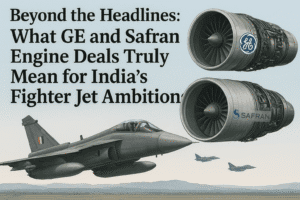Beyond the Headlines: What GE and Safran Engine Deals Truly Mean for India’s Fighter Jet Ambitions
India is advancing on two strategic fronts to secure its fighter jet future. A pivotal deal with GE Aerospace will see the co-production of F414 engines in India, featuring an unprecedented 80% technology transfer to power the crucial Tejas Mk2 jets. Simultaneously, a more ambitious collaboration with France’s Safran aims for the joint design and development of a new, advanced engine with full technology transfer for India’s fifth-generation AMCA program. These partnerships address both immediate squadron needs and long-term indigenous capability. The true challenge now lies in absorbing this complex technology, building a skilled manufacturing ecosystem, and innovating beyond partnership to achieve genuine self-reliance in a domain mastered by very few nations.

Beyond the Headlines: What GE and Safran Engine Deals Truly Mean for India’s Fighter Jet Ambitions
The recent flurry of news about jet engine deals with American and French giants is more than just a procurement update; it’s a defining chapter in India’s decades-long quest for aerial self-reliance. While the headlines announce negotiations and partnerships, the real story lies in the nuanced strategy, the critical distinctions between the two deals, and the high-stakes race against time.
The Two-Pronged Approach: Solving for Today, Building for Tomorrow
India’s engine strategy is brilliantly pragmatic, addressing two different needs with two different partners.
- The GE-HAL F414 Deal: Powering the Immediate Future (LCA Tejas Mk2)
This deal is about certainty and scale. The Light Combat Aircraft (LCA) Tejas Mk2 is a critical program to bolster the Indian Air Force’s depleting squadron strength. It needs a proven, powerful engine—now. The GE F414 is exactly that, powering jets like the F/A-18 Super Hornet and Sweden’s Gripen.
- The Real Win: The breakthrough isn’t just co-production; it’s the unprecedented 80% technology transfer agreed upon after years of negotiation, a significant leap from the 58% offered in 2012. This includes invaluable knowledge in coating materials that withstand extreme heat, machining single-crystal turbine blades, and manufacturing critical “blisk” components (bladed disks).
- The Caveat: It’s crucial to understand that the withheld ~20% likely encompasses the most sensitive “crown jewel” technologies related to core architecture and certain proprietary manufacturing processes. This isn’t a refusal but a reflection of the extreme protectiveness nations have over engine IP. The goal here is not immediate independence but building a deep, foundational understanding to service, maintain, and eventually innovate upon a modern engine.
- The DRDO-Safran Collaboration: Crafting the Strategic Future (AMCA)
This partnership is of a completely different nature. For India’s ambitious 5th-generation Advanced Medium Combat Aircraft (AMCA), an off-the-shelf engine won’t suffice. It requires a new engine with higher thrust and features like thrust-vectoring for supermaneuverability.
- The Ambition: This isn’t just co-production; the stated goal is to “design, develop and produce” a new engine with “full technology transfer.” This implies a joint development project from the ground up, where Indian scientists and engineers from the Gas Turbine Research Establishment (GTRE) would be involved in the core R&D.
- The Greater Challenge & Promise: While more complex and risky, this model offers a genuine path to mastering the entire engine lifecycle. If successful, it wouldn’t just power the AMCA; it would create the indigenous capability to build next-generation engines for India’s future aerial platforms.
The Human and Strategic Imperative: Why This Matters
Prime Minister Modi’s Independence Day call to develop indigenous jet engines wasn’t just rhetoric. It underscores a painful historical lesson. Despite decades of effort, India’s Kaveri engine project struggled due to the immense complexity of metallurgy, precision manufacturing, and systems integration required—a challenge only a handful of nations have ever overcome.
The cascading delay mentioned in the original article isn’t just a bureaucratic slowdown. It directly impacts:
- National Security: The IAF’s squadron strength is below its required levels. Delays in the Tejas Mk2 have a direct effect on operational readiness.
- Economic Sovereignty: Truly “Make in India” means controlling the core technology. Without engine mastery, a significant part of a fighter jet’s value and its maintenance lifecycle remains dependent on foreign suppliers, especially during critical times.
- Technological Ecosystem: Mastering jet engine technology doesn’t stay in aerospace. It spins off advancements in material science, precision engineering, and thermodynamics that benefit the entire manufacturing sector.
Looking Ahead: The Path to True Indigenization
These deals are monumental stepping stones, but the journey is far from over. The real measure of success won’t be the signing of these contracts, but what happens after:
- Absorption and Adaptation: Can Indian industry and DRDO absorb the transferred technology? It will require a massive upskilling of the workforce and quality control at par with global standards.
- From Production to Innovation: The ultimate goal must be to move from assembling and manufacturing known components to innovating new ones. The experience from the F414 must directly feed into and accelerate the Safran-AMCA engine program.
- The Long Game: Jet engine development is measured in decades, not years. This requires sustained political will, consistent funding, and a national commitment that transcends political cycles.
The negotiations with GE and the finalization with Safran are not the end of a process, but the beginning of the most critical phase: turning partnership into genuine, unstoppable proficiency. The future of Indian air power depends on it.
You must be logged in to post a comment.